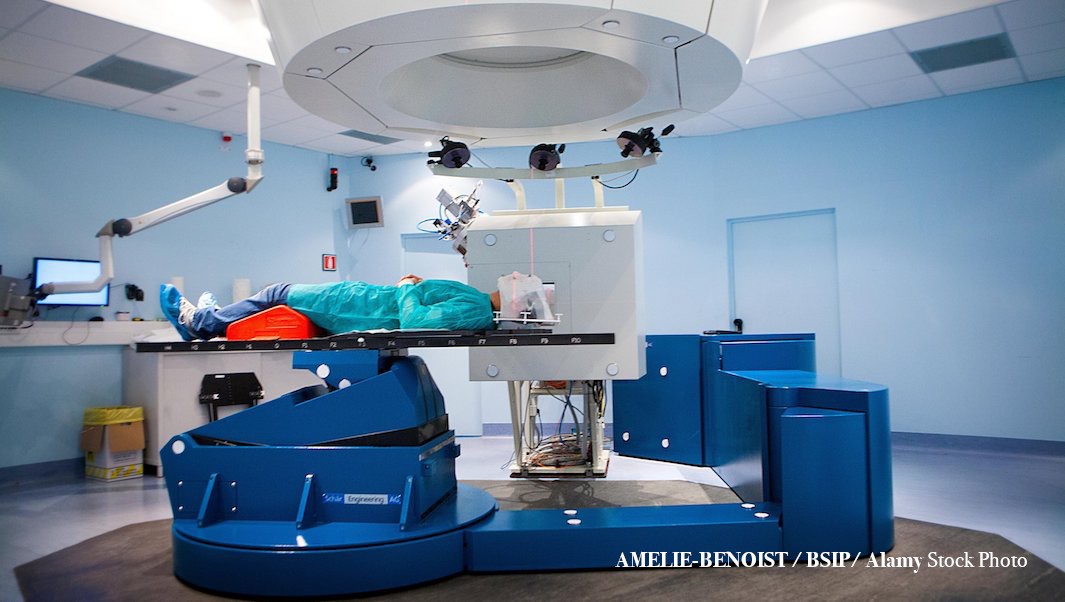New sensor could make cancer treatment more precise
New sensor could make cancer treatment more precise"
- Select a language for the TTS:
- UK English Female
- UK English Male
- US English Female
- US English Male
- Australian Female
- Australian Male
- Language selected: (auto detect) - EN
Play all audios:
The National Center for Oncological Hadrontherapy (CNAO) in Pavia, Italy. Credit: AMELIE-BENOIST /BSIP/Alamy Stock Photo.
One of the biggest problems in hadron therapy – where cancer cells are bombarded with charged particles such as protons — is how to monitor the radiation that hits healthy tissues around a
tumour. Protons can deliver energy at great depths inside the human body because, unlike X-rays used in traditional radiotherapy, they interact weakly with the skin and shallow tissues. But
the intensity and direction of the beam must be precisely targeted. Currently, doctors use computational methods based on the patient’s CT scans, but a sensor inside the body would be a
better option.
Scientists coordinated by Beatrice Fraboni at the University of Bologna, and Alberto Quaranta at the University of Trento, have designed an organic, thin and flexible sensor that can do just
that. The device, described in a study in Science Advances1, is as thin as 125 micrometers and covers a surface of 5 by 6 millimeters. It is made by depositing a layer of organic
semiconductor, based on the hydrocarbon pentacene, on a flexible plastic substrate, and is equipped with two gold electrodes powered with a low-intensity electric field. When protons hit the
sensor, electric charges are generated in the semiconductor, and travel to the electrodes producing a current which corresponds to the energy delivered by the protons.
In experiments at the LABEC ion beam centre of the Istituto Nazionale di Fisica Nucleare (INFN) in Florence, a sequence of proton pulses of different duration and intensity, with an energy
of 5 MeV, were directed at the sensor. “The interaction between the semiconductor and the plastic substrate allows measurement of the dose delivered by each pulse, but also the total dose
received after several pulses”, explains Ilaria Fratelli, PhD student at the University of Bologna, and first author of the study. This is not obvious, because at each pulse, the current in
the semiconductor rises and then falls to a baseline which is higher than the previous one, potentially confounding the measure. But, by accumulating charge, the plastic substrate
‘memorises’ each new baseline and factors it in the measurement. Real-time detection of pulses is useful to adjust the beam at each session, while the total dose measure keeps track of the
radiation received by the patient during the whole treatment.
“The advantage of this sensor is that it mimics the response of human tissue, and does not require a complex calibration procedure, unlike silicon-based devices”, explains Fraboni. The
fabrication of these sensors is not expensive and does not require high-tech processes, and therefore could be easily scaled industrially. Its volume and power consumption are small, which
could make it appealing also for protecting astronauts from space radiation during long-duration missions.
“It’s a very promising result”, says Marco Durante, director of the biophysics department of GSI Helmholtz Centre for Heavy Ion Research in Darmstadt, who was not involved in the research.
“An organic flexible sensor could fit in a rectal balloon to monitor the treatment of prostate cancer, or inside the oral cavity to control the vital organs at risk when treating head and
neck tumours.” He suggests a next step could be to test the sensor with higher energy protons, up to hundreds MeV, such as those used in clinical practice.
Trending News
Mehbooba hopes people come out in good numbers on may 25 to vote for pdpMehbooba hopes people come out in good numbers on May 25 to vote for PDP ISHRAT BHAT May 22, 2024 2:56 pm No Comments Vi...
Bitcoin hits record as stocks, bonds retreat amid market uncertaintyThe price of Bitcoin broke its record on Wednesday, climbing to just shy of $110,000 to eclipse the previous high from J...
Environmental news, opinion and analysis from Guardian US | The GuardianEnvironmentHideCub found alone in US woods now being raised by wildlife staff in bear costumesTwo-month-old black bear, ...
Us refrains from labelling china as currency manipulator, adds india to montitoring list for extra scrutinyThe list was started in 2016. The Trump administration again refrained from naming any major trading partners as currenc...
4 Social Security Mistakes That Leave Money on the Table2:18 Videos de AARP 4 Social Security Mistakes That Leave Money on the Table Facebook Twitter LinkedIn AARP Financial Am...
Latests News
New sensor could make cancer treatment more preciseThe National Center for Oncological Hadrontherapy (CNAO) in Pavia, Italy. Credit: AMELIE-BENOIST /BSIP/Alamy Stock Photo...
Tenet release date moved with wonder woman 1984, matrix 4 and moreMeanwhile, Gal Gadot’s Wonder Woman 1984 has been moved from August 14 to October 2, having moved a few times this year....
Mcmahon joins carson in 'tonight' exit : television: longtime sidekick is stunned by host's surprise announcement to leave show in may after nearly 30“The other shoe,” Ed McMahon said Friday, “has dropped. Finally.” And following Johnny Carson’s surprise announcement on...
Take control, remotely, of your parents’ technology | members onlyYour mom calls and says, “My keyboard is broken. When I press the keys, nothing happens, and the picture on my screen sa...
Dinosaur 200th anniversary collection2024 marks 200 years since William Buckland reported his research on _Megalosaurus_, later recognised as the first non-a...
